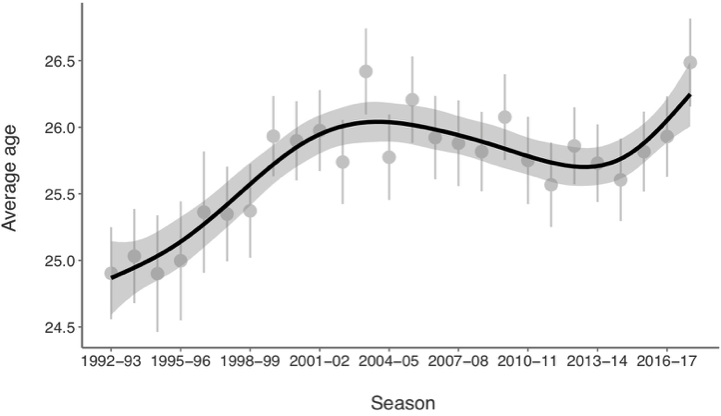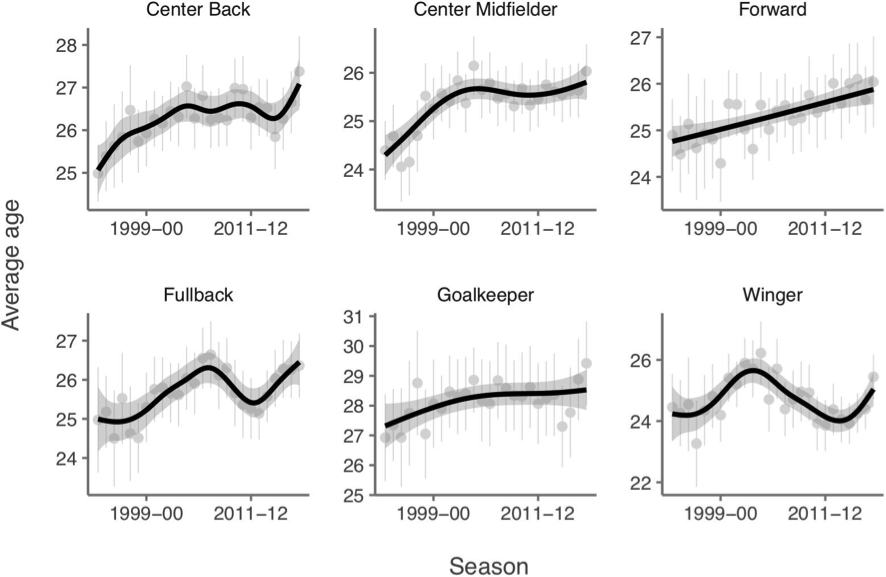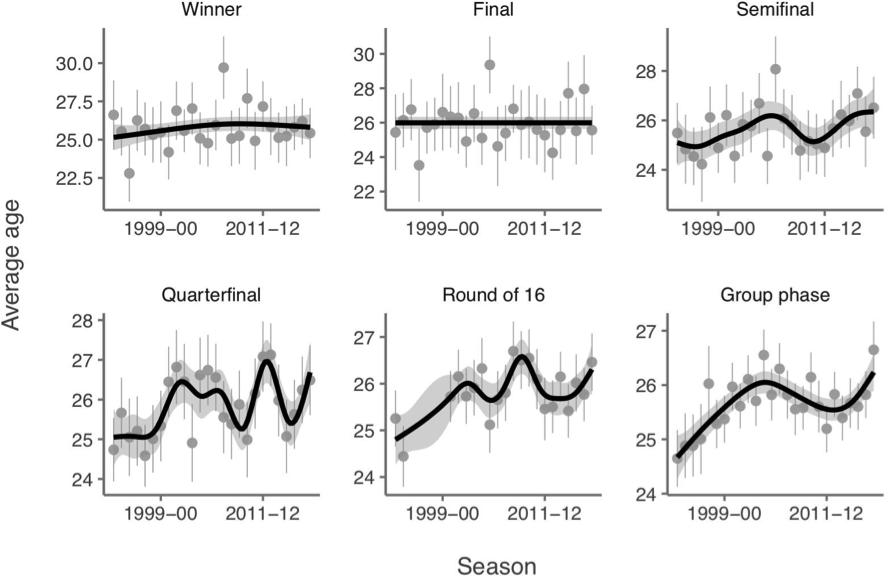Changes in sport are closely linked to changes in society. Life expectancy is increasing and the retirement age has also progressively increased in Spain. This same trend can be seen, for example, in tennis. The average age of the top 100 male players has increased in the last decade in 0.34 years per season, going from an average age of 26.2 in the last decade to a historical high of 27.9 years.1
A recent research study2 confirms that this trend also takes place in football, players are becoming increasingly older. After analysing the ages of all the players who took part in the Champions League between the seasons 1992-1993 and 2017-2018, the researchers discovered a number of interesting findings:
- The average age of football players has increased by 1.6 years, from 24.9 in the first season analysed, to 26.5 in the last season analysed (Figure 1).
- This increase can be seen across all specific positions. Goalkeepers and centre-backs are the positions with the oldest players (Figure 2).
- An inverted U curve characterises the relationship between the market value of players and their age, with the maximum value found in the range of 26 to 30 years old. Players over 30 had a lower value, even lower than players in the 16 to 20-year-old age range.
- There are no age differences between the teams that have won championships and those that were finalists, semi-finalists or eliminated in the first rounds of competition. It appears that a combination of youth and maturity may be the best formula for success (Figure 3).



The explanation as to why football players are getting older is likely related to a combination of multiple factors. Technology, diet, training, injury prevention, money invested and the expertise of nowadays coaching staffs could all be contributing factors. Teams now train better; players take more care of themselves and science has helped to better understand what is needed to make fewer mistakes. It is also possible that we are expanding the limits of performance.
The practical application of these findings suggest that:
1.We should not just focus on signing very young players. The market value of players decreases drastically after the age of 30, however it appears that at this age athletes can still offer quality performance for a number of seasons. Furthermore, an experienced player may possibly require less time to adapt to a new club and play their best from the moment they join the club.
2. The trend of ageing players appears likely to continue in upcoming years. Players are getting older, especially goalkeepers and centre-backs.
3. The investment made by clubs in research, technology and well-qualified coaching staff may all have contributed to maintaining the value of the players.
Sign up for Certificate in Training for Team Sports
Carlos Lago Peñas
References:
1 Kovalchik, S. A. (2014). The older they rise the younger they fall: age and performance trends in men’s professional tennis from 1991 to 2012. J. Quant. Anal. Sports 10, 99–107.
2 Kalén A, Rey E, de Rellán-Guerra AS and Lago-Peñas C (2019) Are Soccer Players Older Now Than Before? Aging Trends and Market Value in the Last Three Decades of the UEFA Champions League. Front. Psychol. 10:76
KNOW MORE
CATEGORY: MARKETING, COMMUNICATION AND MANAGEMENT
This model looks to the future with the requirements and demands of a new era of stadiums, directed toward improving and fulfilling the experiences of fans and spectators, remembering “feeling” and “passion” when designing their business model.
CATEGORY: FOOTBALL SPORTS PERFORMANCE
Through the use of computer vision we can identify some shortcomings in the body orientation of players in different game situations.
CATEGORY: MEDICINE HEALTH AND WELLNESS
A health check must detect situations which, despite not showing obvious symptoms, may endanger athletes subject to the highest demands.
CATEGORY: FOOTBALL TEAM SPORTS
In the words of Johan Cruyff, “Players, in reality, have the ball for 3 minutes, on average. So, the most important thing is: what do you do during those 87 minutes when you do not have the ball? That is what determines whether you’re a good player or not.”
CATEGORY: MEDICINE HEALTH AND WELLNESS SPORTS PERFORMANCE
Muscle injuries account for more than 30% of all injuries in sports like soccer. Their significance is therefore enormous in terms of training sessions and lost game time.
DO YOU WANT TO KNOW MORE?
- SUBSCRIBE
- CONTACT
- APPLY
KEEP UP TO DATE WITH OUR NEWS
Do you have any questions about Barça Universitas?
- Startup
- Research Center
- Corporate